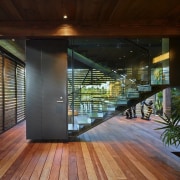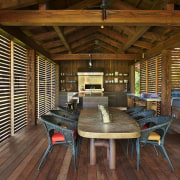The island retreat home
This Hawaii home by Olson Kundig is the ultimate tropical paradise

Architect: Olson KundigPhotography by Benjamin Benschneider
From the architect: This project is difficult to grasp through photographs of the buildings alone, since it is just as much—maybe more—about the gardens and the spaces between the buildings. The house is a series of pavilions framing distinct landscape areas, each with its own microclimate: flowers, desert, agriculture, poolside. The buildings form an enclosure around the lawn—a clearing in the thick foliage—which serves as the heart of the outside experience.

The landscaping references the old plantation vernacular of the island: The coconut palms are on an orthogonal grid; the pool has the rough, board-form concrete found in the irrigation channels; and some of the plants, particularly the taro, are native. The buildings on the ground floor are enclosed in lava stone walls, which references how native islanders built in the past; it’ s as if the project inherited those walls as a remnant from a previous building and built between them and on top of them. The client’s good friend, interior designer Rodman Primack, did a wonderful job relating the interiors to the gardens, landscape, and architecture.
Many of the joints are traditional mortise-and-tenon, using wooden pegs (although some are strengthened with concealed metal braces and screws). This method of construction fell out of favor due to its complexity and the intensity of labor required. It’s made possible here by Spearhead Timberworks, a company we’ve collaborated with many times. They have software that generates extremely accurate cut patterns for a laser CNC router, and the joints are straightforward to put together on site. A lot of the house was actually made at Spearhead, which is in Nelson, British Columbia, and shipped to Hawaii as a kind of glamorous FlatPak.

The boomerang shape of the lot was actually a benefit, because it allowed us to craft a pathway journey. The result feels very natural. The property came with numerous restrictions related to the buildings: the western portion is limited to single-story structures, and the eastern portion is limited to two-story structures. But again, this was an advantage rather than a problem, as it enabled us to modulate not only horizontally though the gardens, but vertically as well. The views of the sea are significantly better one floor up, and everything is built to maximize that.
The Kona Coast is paradise. It was so important that the buildings would breathe both spiritually and actually. That’s why you go to Hawaii—so you can experience the weather, its different moods. You’ve got the beautiful, soft trade winds, but also the Kona winds that you want to be protected from. There’s heat, humidity, rain. So the house has big, deep overhangs, windows and ceilings that open and close, and air conditioning in a few rooms but not all, so you can live as “close to the skin” as is comfortable.
Story by: Trends
Home kitchen bathroom commercial design












